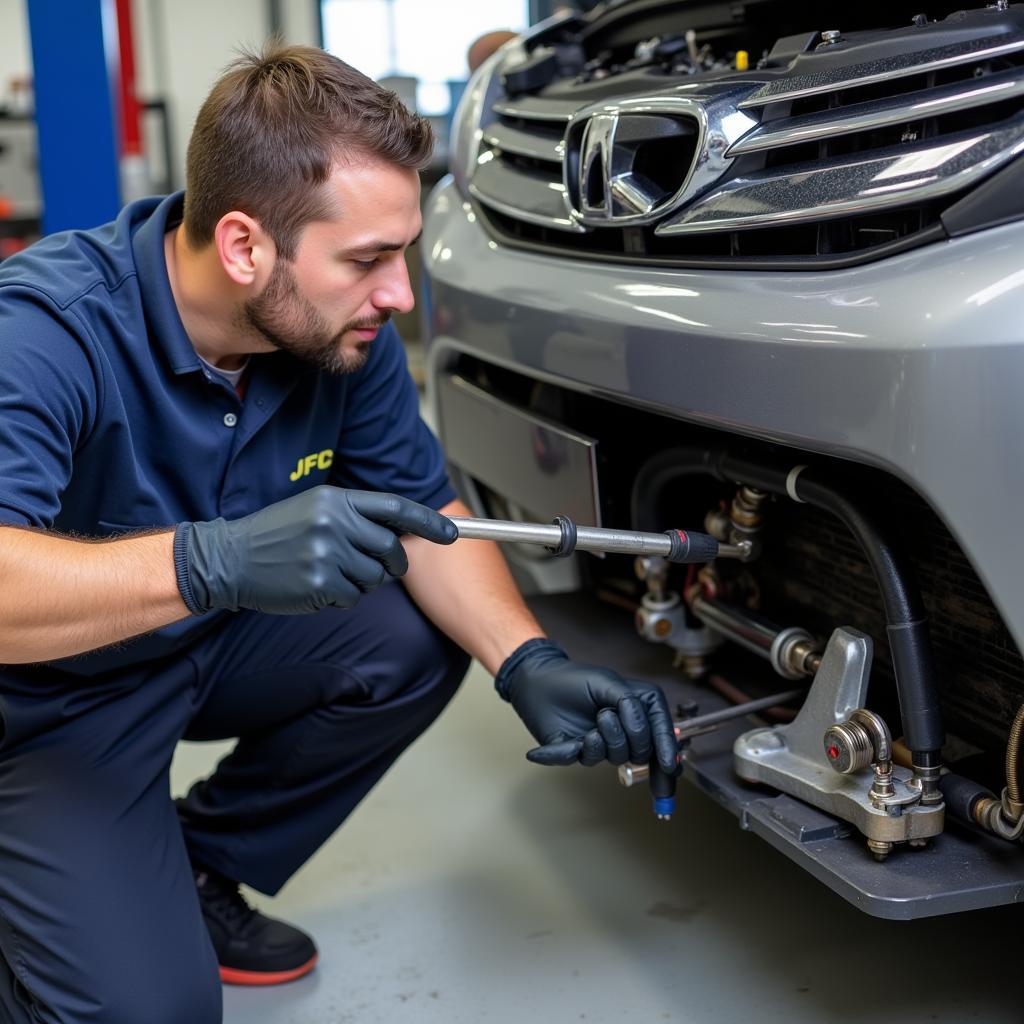The Auto Ac Service Port, also known as the AC pressure switch, plays a crucial role in your car’s air conditioning system. It acts as the gatekeeper, controlling the flow of refrigerant based on the pressure levels within the system. This article delves into the intricacies of the auto AC service port, providing valuable insights for car owners and enthusiasts alike.
What is an Auto AC Service Port?
The auto AC service port is a small, but vital component typically located within the engine bay. It features a valve system that allows technicians to connect specialized equipment for various maintenance tasks. These tasks include:
- Refrigerant Recovery: Removing old or contaminated refrigerant from the system.
- Vacuuming: Evacuating air and moisture from the system, crucial for optimal performance.
- Recharging: Refilling the system with the appropriate type and amount of refrigerant.
- Leak Detection: Identifying and locating leaks within the AC system.
Types of Auto AC Service Ports
There are two main types of auto AC service ports:
- High-Side Port: This port, usually distinguished by a red cap, connects to the high-pressure side of the AC system.
- Low-Side Port: Identified by a blue cap, this port connects to the low-pressure side of the AC system.
Both ports are essential for proper AC service and require specialized equipment to access.
The Importance of the Auto AC Service Port
The auto AC service port is indispensable for maintaining a functional and efficient car AC system.
- Preventing System Damage: The pressure-sensitive valve within the port prevents overfilling or excessively low pressure, safeguarding the AC system from potential damage.
- Ensuring Optimal Performance: By facilitating proper refrigerant levels, the service port ensures that your AC system operates at peak efficiency, providing optimal cooling during hot weather.
Common Issues with Auto AC Service Ports
While durable, auto AC service ports can encounter problems, often leading to AC performance issues. These problems include:
- Refrigerant Leaks: A leaking service port can lead to a gradual or sudden loss of refrigerant, causing your AC to blow warm air.
- Clogged Ports: Debris or corrosion can obstruct the service port, hindering refrigerant flow and affecting system performance.
- Damaged Valves: Wear and tear or improper handling can damage the valve mechanism, compromising the port’s functionality.
When to Seek Professional Help
If you suspect any issues with your auto AC service port or experience problems with your AC system, it’s crucial to seek professional help. Tampering with the AC system without proper knowledge and equipment can lead to further damage and potential safety hazards. Qualified technicians possess the expertise, tools, and knowledge to diagnose and resolve any problems effectively.
Maintaining Your Auto AC System
Regular maintenance is key to prolonging the life of your car’s AC system and ensuring optimal performance. Here are some essential maintenance tips:
- Schedule Annual AC Service: Have your AC system inspected and serviced by a qualified technician at least once a year, preferably before the start of the summer season.
- Visually Inspect the Service Ports: Regularly check the service ports for any signs of damage, leaks, or corrosion.
- Keep the AC System Running: Even during colder months, run your car’s AC for a few minutes every couple of weeks to keep the refrigerant circulating and lubricate the system’s components.
 Auto AC Service by a Professional
Auto AC Service by a Professional
Conclusion
The auto AC service port might seem like a small detail, but its role is critical for a comfortable and enjoyable driving experience, especially during warmer months. Understanding its function and potential issues empowers car owners to take proactive measures in maintaining their AC systems. Remember, regular maintenance and timely professional attention are essential to ensure a cool and comfortable ride for years to come.
Don’t hesitate to contact our team of auto AC experts at auto ac service portland or for all your AC service and repair needs.
FAQs
1. How often should I recharge my car’s AC?
Ideally, a well-maintained car AC system should not require frequent recharging. However, if you notice reduced cooling efficiency, it’s best to have the system inspected for potential leaks or other issues.
2. Can I add refrigerant to my car’s AC myself?
While DIY refrigerant recharge kits are available, it’s highly recommended to leave this task to professionals. Improper handling of refrigerant can be hazardous to both your health and the environment.
3. How much does it cost to repair a leaking auto AC service port?
The cost of repair depends on the severity of the leak, the type of vehicle, and labor costs in your area. It’s best to get a quote from a trusted mechanic for an accurate estimate.
4. Can a damaged auto AC service port affect my car’s engine?
While a damaged service port won’t directly affect the engine, a malfunctioning AC system can put extra strain on the engine, potentially impacting fuel efficiency.
5. What type of refrigerant does my car use?
The type of refrigerant varies depending on the make, model, and year of your car. You can find this information in your owner’s manual or consult with a qualified technician.
Need Help with Your Car’s AC System?
For expert assistance, contact us via WhatsApp: +1(641)206-8880 or email us at: [email protected]. Our dedicated customer support team is available 24/7 to answer your questions and schedule appointments.
Explore More:
- Learn about auto ac service port nipple and its function.
- Discover the convenience of auto transport with tracking service.
- Find affordable auto glass service portland or.
- Manage your car finances easily with ally auto login customer service.

